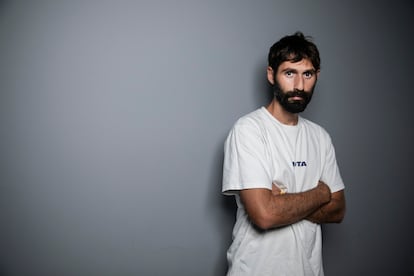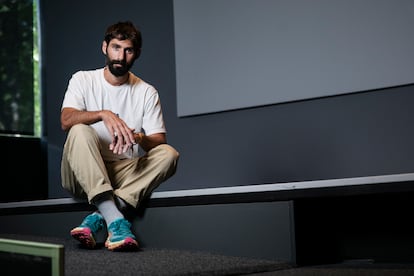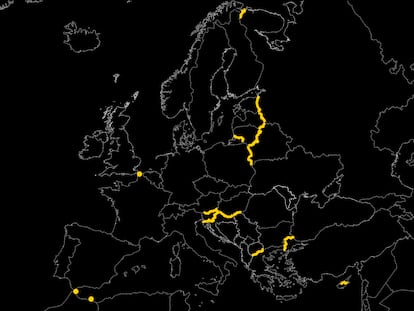Stefanos Levidis, a researcher with Forensic Architecture: ‘There’s usually a dominant narrative put forward by the state… we have a reason not to trust it’
The Athenian is a member of the research group that uses architectural techniques and technologies to investigate cases of state violence. He sat down with EL PAÍS to discuss violence and migration


“Don’t come to Greece on vacation – the sea is full of bodies,” Stefanos Levidis warns in a tweet. This 34-year-old Athenian thought he would be an architect. But while studying for his degree, he understood that he wasn’t meant to create buildings. Involved with the Greek refugee crisis for almost a decade, Levidis works as a migration researcher at Forensic Architecture – a project that denounces human rights injustices committed by police forces, militaries and corporations around the world. Their work – which involves innovative professionals working as both visual artists and criminal investigators – has exposed abuses of power and led to criminal convictions.
Levidis – a finalist for the Turner Architecture Prize in 2018 – has come to Barcelona to give a talk on violence and borders at the Sónar +D conference. It was within this space that he sat down for an interview with EL PAÍS.
Question. How does Forensic Architecture work?
Answer. It’s a way of understanding the world and space. If something happens, it leaves a trail of evidence. As architects, we have the tools to unpack it, reread it, understand it. And it’s much easier today, in a society where we live enmeshed with systems of surveillance. Violent events are recorded by camera and phone and uploaded to social media. We apply architectural modelling to understand the relationship between these images in a logical way and reconstruct the [events in question], while adding other evidence or documents that we have accessed, to [provide] order and meaning. That’s what Forensic Architecture is for.
Q. Your goal is social justice.
A. Yes. There’s usually a dominant narrative put forward by the state… we have a reason not to trust this narrative. We work with evidence and spatial analysis to project counter-narratives – counter evidence – or what we call “counter-forensics.”
We’re a multidisciplinary team made up of architects, but also investigative journalists, filmmakers, artists [and] software developers. We always work in partnership with civil society organizations to look into incidents of state violence, where vulnerable individuals have their rights violated by states. We use tools that are publicly available: architectural tools, filmmaking tools… we use architecture to unpack space, basically to understand what has happened in a specific event.
Q. One of your projects resulted in evidence being brought to court against the conviction of six individuals from the Moria Refugee Camp, who were imprisoned for causing forest fires in Lesbos, Greece, in 2020.
A. This project was coordinated by my colleague, Dimitra Andrisou. We were contacted by the lawyers representing the defendants, who were arrested a few hours after the fire because the Greek government wanted to appear [tough-on-crime] without even having seen the forensic evidence.
Q. What conclusions has your investigation reached?
A. Almost all the materials that make up a refugee camp – such as plastic – are highly flammable. In the camps, almost every day, there are fires… but this was the one that spread throughout the space. Basically, it was designed to burn… the authorities let it burn.
Our analysis proves that the camp couldn’t have been burned by [the six people].
Q. Can you elaborate?
A. It was a very windy day. We can prove that the fire spread through the air and that those six people couldn’t have caused the fire by themselves. Last March, we traveled to Lesbos to present the evidence. [The hearing] has been postponed until March of 2024. Unfortunately, those six people will continue to wait for justice for another year behind bars… time is weaponized by justice.

Q. You coordinated the investigation into the murder of rapper and anti-fascist militant Pavlos Fyssas. The reconstruction influenced the judges in the case.
A. We were contacted by Pavlos’s family, who had full access to the evidence and court documents we needed. They sensed that the police had not done their job properly, either in analyzing the evidence or in synchronizing the recordings of the incident, in which members of the Golden Dawn (a neo-Nazi party) murdered Fyssas, in September of 2013.
There were two main findings [from our investigation]. One, that the Golden Dawn members who murdered Pavlos arrived together in a coordinated manner – on scooters and in cars – from the direction of their local headquarters. This was important, because what was being claimed in court and by the media was that [the men] had argued [with Pavlos] over football and they killed him, and that they just happened to be Golden Dawn supporters. But we showed that this was coordinated.
The other important finding is that we proved that the police were lying. The police that were present on the scene had erased five minutes from their testimony, saying that they arrived five minutes later, which would mean that they arrived too late to stop the murder. But we see them in [security camera footage]. We submitted this to court and it was taken seriously by the judge. As we can see from the results, [the evidence] helped in the conviction of a criminal organization.
Q. Are you usually taken seriously?
A. What we do is something new – not all courts are open to these techniques. A colleague was not allowed [to present] her reconstruction of the murder of Zak Kostopoulos – a young LGBTQ activist and member of the Athens drag queen community – who was murdered in broad daylight in the city center. The video couldn’t be shown at the trial, but she took the stand and was able to recount our step-by-step reconstruction of the events. Judges don’t like reconstruction clips. They believe that the montage can lead to the display of false information. But we’re very transparent with our methodology and the steps we’ve taken to reach our conclusions.
Q. Is it hard to claim to be a reliable source in these times of conspiracy theories and misinformation?
A. Yes, it makes our job more difficult, but it also makes it more relevant. We need images to talk to each other reliably, with evidence. If [our images] were fake, it would be noticeable.
Q. With contemporary culture’s ongoing consumption fever for true crime stories – both via podcasts and documentary series – doesn’t it scare you to think that everyone thinks they can solve a crime nowadays?
A. I have no comment on the shows. I haven’t seen them. But I suppose that if people have become hooked, it’s because they’re trying to validate the information they see – there’s a level of mistrust.
We always say that our work doesn’t end in our lab. When we finish an investigation, we always have to think of the afterlife of the project – how this [information] will be presented to the world and how we can achieve maximum political change. Working with journalists is important.
Q. What’s your defense mechanism when you work on such sensitive investigations?
A. At Forensic Architecture, we do trainings on trauma and vicarious trauma. We have a certain set of protocols on how to work with sensitive material and when not to engage. [For instance], we mask parts of the videos, so you don’t have to see certain scenes over and over again. You only see a very violent piece of footage if it’s absolutely essential. Just one person sees it and tells the rest [of the team] what it shows. We try to protect ourselves from this kind of exposure – it’s an important part of our process.
Q. Is there any historical event to which you would have liked to apply your forensic architecture techniques?
A. Yes. Before I joined Forensic Architecture, there was a case in Greece: Alexandros Grigorópulos – a 16-year-old boy – was shot by police in 2008. His case sparked massive protests. At that time, I lived in Athens. We were all very deeply shocked. And thinking back, I wish I was with Forensic Architecture – I wish it existed then. Because [the case] raised all the questions we try to answer. Whether the bullet was fired directly to the body of the young person, or if it ricocheted from a wall, as a policeman said. So I wish [Forensic Architecture] existed then. We could have looked into it.
Sign up for our weekly newsletter to get more English-language news coverage from EL PAÍS USA Edition
Tu suscripción se está usando en otro dispositivo
¿Quieres añadir otro usuario a tu suscripción?
Si continúas leyendo en este dispositivo, no se podrá leer en el otro.
FlechaTu suscripción se está usando en otro dispositivo y solo puedes acceder a EL PAÍS desde un dispositivo a la vez.
Si quieres compartir tu cuenta, cambia tu suscripción a la modalidad Premium, así podrás añadir otro usuario. Cada uno accederá con su propia cuenta de email, lo que os permitirá personalizar vuestra experiencia en EL PAÍS.
¿Tienes una suscripción de empresa? Accede aquí para contratar más cuentas.
En el caso de no saber quién está usando tu cuenta, te recomendamos cambiar tu contraseña aquí.
Si decides continuar compartiendo tu cuenta, este mensaje se mostrará en tu dispositivo y en el de la otra persona que está usando tu cuenta de forma indefinida, afectando a tu experiencia de lectura. Puedes consultar aquí los términos y condiciones de la suscripción digital.
More information
Últimas noticias
Not all insomnia is the same: Study identifies five subtypes and paves the way for personalized treatment
The United States designates Clan del Golfo as a foreign terrorist group
The United States strikes three more suspected drug boats, killing eight
The Iberian Peninsula is rotating clockwise, scientists report
Most viewed
- ‘El Limones’ and the growing union disguise of Mexican organized crime
- Christian Louboutin: ‘Young people don’t want to be like their parents. And if their parents wear sneakers, they’re going to look for something else’
- ‘We are dying’: Cuba sinks into a health crisis amid medicine shortages and misdiagnosis
- A mountaineer, accused of manslaughter for the death of his partner during a climb: He silenced his phone and refused a helicopter rescue
- The low-cost creative revolution: How technology is making art accessible to everyone










































